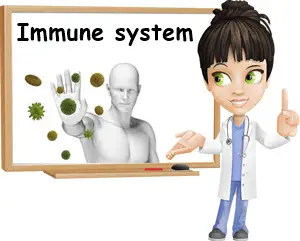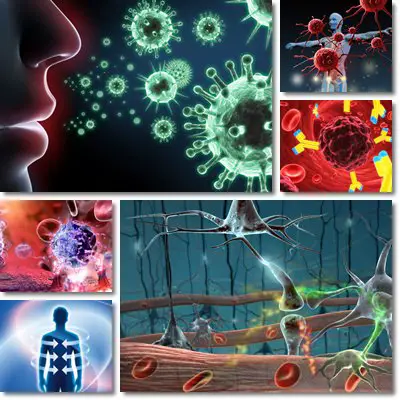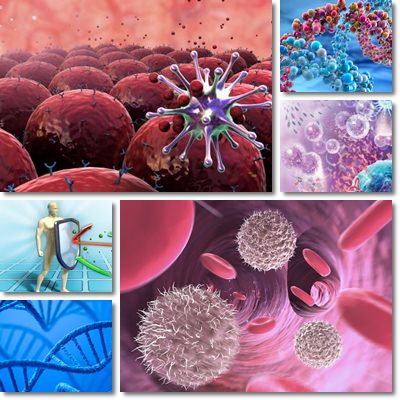The immune system consists of the cells, tissues, organs, systems, reactions, reflexes, processes and mechanisms that protect our body from disease, whatever form it may take. The immune system works in such a way that it differentiates between what is part of the body and what is not. In other words, it recognizes foreign organisms or compounds that manage to invade the body and sets out to eliminate them before they produce disease and harm. Our immune system is so efficient that it can practically protect us from any type of infection or disease, provided, of course, it is working as it should.
What is the immune system? The immune system comprises cells, tissues, organs, systems, processes, reflexes and mechanisms that make up the body’s response to any potentially harmful living organism or agent that might produce infection and disease. It is a highly intelligent and incredibly complex system capable of learning and adapting, characteristics that ensure it can keep up with evolving pathogens. The immune system is so efficient that it creates a database for pathogens, marking its encounters with every disease-producing agent it comes into contact with. This helps in a faster identification and a more efficient future immune system action.

The immune system is a fairly unspecific notion that includes a host of different components with specific functions whose activity ensures protection against infection and disease. The following terms contribute to a better understanding of the immune system and how it works:
1) White blood cells. They are known as leukocytes and represent the cells of the immune system. There are different types of white blood cells, each with specific functions. Their general purpose is to protect against infection and disease.
2) Antibodies (immunoglobulin). They are proteins that identify bacteria, viruses and other potentially harmful agents and are produced by the adaptive immune system. Antibodies recognize threats to the immune system by binding to certain molecules on them called antigens.
3) Antigen. An antigen is a certain molecule of a bacteria or virus that an antibody recognizes and binds to. It is a molecule that elicits a response from the immune system.
4) Pathogen. It refers to microorganisms such as bacteria, viruses, fungi, prions (other types of infectious agents), parasites. Other disease-causing elements include toxins, dysfunctional cells (tumor cells), irritants.
How does the immune system work?
Disease installs when foreign bodies invade our system and produce damage. These foreign bodies may include living microorganisms such as bacteria, viruses, fungi or protozoa (referred to as pathogens or infectious agents) or non-living compounds such as toxins of varying nature. Their common trait is that they produce disease. Normally, our body’s first line of defense prevents everything that may cause disease from getting in. Our skin, mucous membranes at the level of the eyes, nose, throat, stomach, lungs prevent anything from getting into our system. Maintaining an excellent hygiene contributes to a stronger first line of defense and fewer infections.
Good to know: a sufficiently generous intake of vitamin A, preferably from food sources, helps ensure the integrity of such membranes, hence the immune-boosting role of vitamin A. Other great vitamins and minerals for a strong immune system include vitamins C and D, B vitamins (especially vitamins B6 and B9), zinc, copper, iron, selenium and manganese. See my list of the best vitamins and minerals for a strong immune system.

However, in some cases, pathogens or other compounds may breach the skin or mucous membranes through cuts, stings, ulcerations, as a result of immune deficiencies, existent disease etc. Once in, these disease-causing elements set off to produce damage and attack cells and systems. Almost as soon as they get into our system, they are detected and the innate (natural) immune system reacts to their presence in an attempt to neutralize them.
When pathogens are too strong, too many or have evolved to take on new characteristics that make them more dangerous, the adaptive immune system kicks in and sets off to identify the threats and take appropriate action against them. If the infection is produced by a new kind of pathogen, the adaptive immune system will create a memory of that pathogen and, should a future reinfection occur, rely on its previous knowledge of how to handle the said pathogen, usually resulting in a faster, more efficient action.
Types of immunity
Our immune system is naturally set to recognize the body and all of its elements and differentiate between what should be there and what shouldn’t. In other words, it is able to identify outside elements that may produce harm and disease. But this action is divided into a more general immune system response and a very specific immune system response aimed at actively learning to identify new threats, microorganisms or non-living elements, and adapting to deal with them appropriately. This has lead to the identification of the following types of immunity:
1) Innate immune system. The innate immune system refers to that part of the immune system that triggers a sort of predefined response. This is a more general action in which immune system cells responsible for neutralizing potential threats set out to identify certain patterns that do not correspond with their ‘knowledge’ of what various elements in the body should look like. This may include cells with an abnormal behavior, general types of microorganisms, toxins etc. Different cells are equipped to recognize different general types of problematic microorganisms or compounds. The innate immune system response is a sort of ‘be prepared for everything’ type of reaction.
2) Adaptive immune system. As its name suggests, this part of the immune system response is highly specific because the immune system actively adapts to recognize and neutralize specific pathogens or other problematic compounds or substances. Once the immune system deals with a specific pathogen, it creates a memory cell to remember it in case of a future re-encounter. Should we get infected again with that same pathogen, certain cells in the immune system will automatically recognize it and proceed to have it neutralized before it can produce serious damage.
Because of its previous experience with and knowledge about it, the immune system response is much more specific and efficient. This is also known as acquired immunity because the immune system acquires such abilities following infection with various pathogens and adapts to identifying their characteristics to deal with them more efficiently in the future.
Passive immunity. Actually, passive immunity is more of a subtype of the immune system response and is characteristic of unborn babies and newborns in general. What passive immunity basically does is lend the mother’s immune system antibodies to the unborn and newborn child. For example, the mother lends her antibodies to the fetus to protect it while still in the womb. These antibodies may remain with the newly born child for a certain period of time after birth to protect against disease until the newly born child’s own immune system starts developing.
When a child is born, he or she has had no contact with bacteria, viruses or other pathogens of harmful compounds so his or her immune system is basically blank. Although there is nothing wrong with it, it isn’t equipped to protect the newborn either, so the newborn has to rely mostly on the mother’s immune system to continue to protect him or her while he or she is slowly developing his or hers by making antibodies. In addition to nutritious elements, mother’s milk also contains the mother’s antibodies that are transferred to the newborn when feeding and offer protection against diseases the mother has dealt with in the past.
Colostrum, the first milk the mother of all mammal species produces, is particularly rich in antibodies and its primary purpose is to give a helping hand to the newborn baby’s immunity. These antibodies from the colostrum will line the infant’s gut and offer protection by preventing pathogens to pass through the gut into the bloodstream. Passive immunity may continue for as long as the mother nurses the child, but it is not permanent.
Immune system and age
Immunity in children versus immunity in adults and the elderly. Newborns do not have a developed immune system, so they have to rely on the mother’s immune system to protect them. This is why newborns and young children get sick more often than adults whose immune system is developed and strong. Also, as we age, our immune system may become less efficient, which is why the elderly are more severely affected by infectious diseases such as the flu.

Vaccination and the immune system
Vaccination basically consists of exposing our body to antigens of certain pathogens to help us develop immunity against the said pathogens. Vaccination offers a sort of long-term immunity and its primary purpose is to prevent particularly virulent infections such as influenza, polio, typhoid fever, chicken pox or cholera. It is an artificial means to boost immunity. Vaccination may consist of exposure to inactive pathogens that cannot multiply, but can be recognized and memorized by the immune system in case infection with a live pathogen may occur sometimes in the future.
It can also consist of exposure to attenuated (weak, less virulent) pathogens that the immune system can handle fairly easily, but also exposure to parts of a pathogen or isolated proteins that only allow for recognition by the immune system, not infection. Vaccination is different from inoculation. The latter allows for direct exposure to living, potentially very virulent pathogens in order to trigger the disease in an individual and allow for antibody production, but it does not prevent severe forms of the disease from developing. Vaccination also contributes to herd immunity.
How does herd immunity work? As a result of vaccination, the majority of the members of a community become immune to a certain infectious disease, so they are either less likely to develop it in the first place because they have antibodies that identify the pathogen before it produces the full blown disease, or develop mild forms that are less virulent and thus less likely to affect members of the community with poor or compromised immunity or who have not been vaccinated against the disease.
Components
What are the components of the immune system? Our immune system is a sort of network that employs proteins, cells, tissues and entire organs and systems to protect the body from any form of disease from infectious agents, toxins or other disease-causing agents. As a result, it includes the following components:
1) Cells. White blood cells (leucocytes, leukocytes) act independently, as an immunity organ, taking on different functions to protect the body from infection and disease. Phagocytes, for example, are white blood cells that eat pathogens and other potentially harmful compounds or cell debris. Neutrophils, macrophages and dendritic cells are all types of phagocytes that reside in different parts of the body such as the bloodstream, tissues or in areas in direct contact with the exterior such as the nose or lungs. Natural killer cells destroy infected or damaged cells, including tumor cells. Lymphocytes (B cells, T cells) are white blood cells that recognize specific traits of pathogens or diseased cells. Killer T cells, a subtype, kill infected or damaged cells, while helper T cells, another subtype, produce signals that identify infected cells and signal the right white blood cells about their presence.
2) Tissues. The mucous membranes lining the nose, mouth, throat, lungs, stomach etc. prevent various infectious agents from getting inside the body. For example, the lining of our throat is moist and contains mucus, blocking most airborne pathogens that may reach our lungs. The tiny hair-like structures that line the mucous lining of the throat also move and help send trapped pathogens out of the body.
3) Organs. Entire organs are part of the network that is the immune system and actively contribute to the immune response. Bone marrow is a principal lymphoid organ along with the thymus, a gland somewhere above the heart. This is because white blood cells are produced in the bone marrow and mature in the thymus. The lymph nodes, tonsils, spleen, mucous membranes, appendix and bowel are secondary lymphoid organs (see what are the organs of the immune system) because they harbor mature white blood cells ready to intervene in case of infection and disease. If our throat, for example, comes into contact with bacteria, the tonsils activate the immune system by sending out white blood cells to fight against an infection well before the said bacteria advances in our body.
4) Mechanisms, reflexes, processes. At cell level, phagocytes (white blood cells) eat up bacteria, viruses or infected cells in a process called phagocitosys, an important immune system mechanism. Reactions such as coughing or sneezing help reduce pathogen load and eliminate dead bacteria or viruses following an infection. Fever in case of an infection raises the temperature in the body to destroy pathogens. All sorts of reflexes and processes aid the immune system in fighting off infection and disease and testify to the complexity of our body’s natural defense system.
